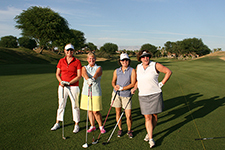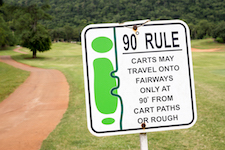HOLE 4:
ETIQUETTE & RULES
Golf has a long history, and many of its traditions, practices, and unspoken rules are not intuitive. Unless you know the etiquette and rules of the game, you may have no idea that you crossed a line. Because we don’t want you to accidentally damage your professional or personal image, in this section you will learn many of the spoken and unspoken rules of golf. Though you may not win awards for your swing, you will attract positive attention when you follow the etiquette and rules of the game.
BASIC GOLF ETIQUETTE
Introduction
Golf etiquette goes beyond everyday manners. It encompasses the safety of golfers, respecting the course, and playing at a good pace. When in doubt, follow the example of more experienced players.
Respect Other Players
MIND YOUR MANNERS
Just as in business or social situations, common courtesies are expected on the golf course. Some are obvious, but others are not. You would never wear yoga gear to a high tea, and you know it’s not the end of the world to be fashionably late to a dinner party.
However, in a golf environment, dressing properly and being on time is expected. If you show up in jeans or a tank top, you'll be making an expensive stop in the pro shop. If you have a 2pm tee time, you're ready to take your first shot at precisely 2pm. In fact, you're expected to be standing near the first hole at least five minutes early - if not, you may lose your spot to play.
Can you carry your golf clubs into the clubhouse? No. Can you share a bag of clubs when you play on the course? It depends. Most courses require that everyone on the course have their own set.
Is it customary to tip? It’s not a bad idea to bring cash so you can tip the people who help with your clubs. How much do I tip? The amount of the tip goes up in relation to the golf fees charged at the course.
KNOW WHEN TO BE QUIET
Golf is a social game, but it’s time to pause the conversation when a player steps up to her ball and prepares for her next shot. In fact, all noise within earshot of the player is expected to cease. This means no rooting around in your golf bag to find a club, speaking on your cell phone, taking practice swings nearby, or chatting loudly at the beverage cart.
Before you walk onto the first tee, switch your phone to vibrate so calls don't inadvertently interrupt someone's turn.
BE A TEAM PLAYER
Many people enjoy golf to escape from the stresses of everyday life, if only for a few hours. Be in the present moment and stay engaged with your group. That's why you're out there, right? It appears rude to be "elsewhere" during the round. There are many ways to be part of the group even if you decide to sit out a hole or two. Stand on the tee box to watch where the ball lands, get out of your cart to help players look for lost balls, and bring your partner her putter if she is on the other side of the course.
WATCH WHERE YOU STAND
When a player is swinging, not only is it dangerous to stand close by, but it’s considered bad etiquette to stand within a player's peripheral vision. The same applies for your shadow on a sunny day. It’s usually safe to stand a short distance from the player facing either her front or back and staying behind the line of play for safety.
PLAY "READY GOLF"
Golf is a time consuming game – don’t take up more than your share! Be ready when it’s your turn. While other players are taking their shots, think about your club choice, move closer to your ball and have a tee and ball marker handy.
The rules of golf dictate that the player furthest from the hole determines the order of play. However, if you are playing "ready golf," you may play out of order to speed up the game. In this situation, be careful never to position yourself in front of someone hitting the ball. Not only is this unsafe, but it is distracting for the golfer taking her turn.
PACE OF PLAY
You will hear people talk a lot about the pace of play. Golf courses start groups anywhere from 8 to 10 minutes apart, and they expect everyone to move forward at the same pace to avoid back ups. The time your group spends in between shots is often the difference between an "on time" round or slowing down the entire field behind you.
Most courses want you to play an 18 hole round in about four and a half hours. This gives your group about 15 minutes per hole. Divide that by four players, and you have less than four minutes to get your ball into the hole. A group of timid players can take up four minutes just deciding who should go first!
Stick to what we like to call the 30 SECOND RULE. Keep the time spent taking your shot, traveling to your ball, and walking off the putting green after completing the hole to a minimum. Say goodbye to your golf ball if you can’t find it in 30 seconds, and play another ball.
CONTROL YOUR EMOTIONS
It’s no secret that golf is a difficult game, even for the best of players. Swearing, yelling, sulking, apologizing or taking your anger out on your club not only makes everyone uneasy, but it can be distracting to other players and affect their game and enjoyment. Remain positive, and your playing partners will enjoy your company.
ONE AND DONE
One swing and your turn is over no matter where the ball goes. Save the analysis of why you missed, topped, sliced or completely whiffed for the practice range. This will save frustration all around!



Respect The Golf Course
DRIVING THE CART
The golf course is one of the few place where it's okay to drink and drive, but driving a cart does come with a few rules. The starter at the beginning of the round will often explain where carts are allowed and not allowed to go. A common instruction is the 90 DEGREE RULE, which means whenever you veer off the cart path and head toward your ball, you'll want to enter the course at a right angle (90 degrees) to get to the ball. This helps keep the carts from driving over the same areas and wearing a path in the ground.
When the starter tells you it's CART PATH ONLY, that means your cart must remain on the path at all times. When the ground is particularly wet or the grass is new, you'll be asked to avoid driving on the course.
You're always safe sticking to the cart path and other designated areas. Abide by all cart signs and markers, and never under any circumstance drive onto the tee box or within 25-30 yards of a putting green.
ON THE TEE BOX
Remove your tee after you take your shot. That leaves the area clear for the next player to choose where to tee up her ball.
ON THE FAIRWAY
Repair your divots by filling in the bare spot with the grass you displaced or with a sand and seed mix provided by the course, often equipped on your golf cart.
IN THE SAND
Avoid an embarrassing moment and enter sand bunkers on the shallow side, rather then navigating the steeper slopes and risking a fall. Take a rake with you to quickly smooth the area marked by footprints and your swing (or swings). Replace the rake outside the bunker for the next player.
ON THE PUTTING GREEN
The putting green has some very specific rules. Use a ball marker to properly identify your ball position when you pick it up; repair divots caused by your ball landing on the green; place a pulled flag gently on the ground as to not to disturb the putting surface; and do not step on another player's LINE, which is the invisible path between their ball and the hole.
Ask your golf instructor to demonstrate these important practices during your putting lesson.
BRING YOUR "A" GAME
If you’re not going to win any awards for your swing, you can absolutely stand out by trying your best and being a good sport! There are many strategies you can use to enjoy the game as you learn and improve which we will share in Hole #8. Considering that only 10% of all golfers (and there are 25 million of them) can break 100, there numerous reasons people play the game that have nothing to do with an impressive scorecard.
One tip that has saved us when a hole is particularly frustrating: Pick up the ball, put it in your pocket and say, "I’ve had enough fun on this hole.” There is aways another tee box ahead!







